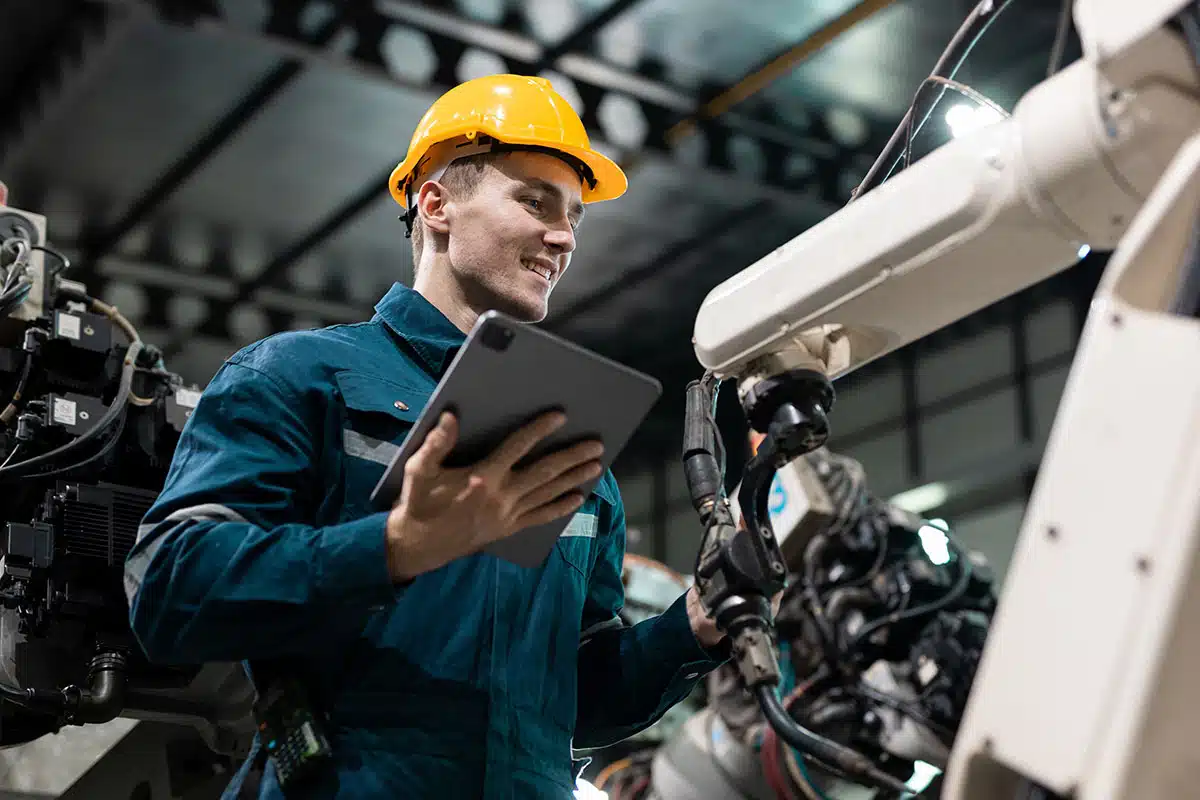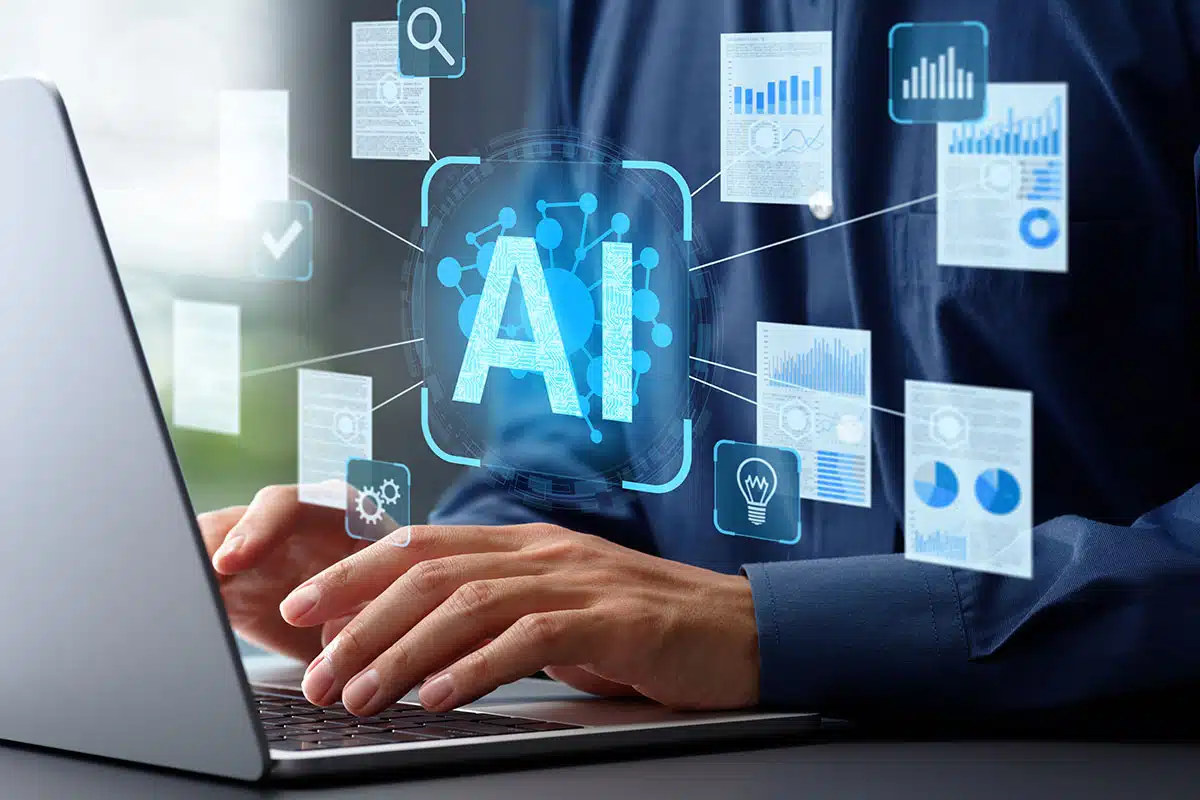This is Part One of a two-part series on the integration of AI and manufacturing. This blog focuses on the benefits of using AI for manufacturing. Read Part Two here.
Chatbots, virtual assistants, and in-home smart devices have made AI such a ubiquitous part of daily life that people are beginning to take it for granted. But what’s true for people isn’t always true for companies, and if your business isn’t taking advantage of AI for manufacturing as a catalyst for efficiency, innovation, and competitiveness, it’s at a disadvantage.
Artificial intelligence—at least in its most rudimentary form—has been around for 50 years. It was first used by electronics manufacturers in the 1970s in the form of computer-aided design (CAD) and computer numerical control (CNC) machines. Engineers used these early software-driven tools to create and modify product designs more accurately and efficiently. Over time, these systems became more advanced as they began to incorporate algorithms and machine learning.
By delivering continuous, accurate, and actionable insights in real time, AI transforms logistics monitoring from reactive to proactive.
Fast forward to this decade, and AI is far more advanced. Whereas traditional AI typically provides information or recommendations for action, a new form of AI, “agentic” AI, has systems that go further. Gartner, a global technology research firm, describes “agentic” AI as a new generation of artificial intelligence systems that work autonomously to achieve goals. These systems can plan, reason, and adapt—without the need for constant human interaction. And if granted the authority, they can even make decisions and execute tasks independently across complex workflows, business processes, and company departments. Gartner predicts that half of all cross-functional supply chain management systems will incorporate agentic AI by 2030.
Why AI for Manufacturing?
Electronics manufacturers are facing challenges across multiple fronts. Rapid advances in electronics are fueling a seemingly insatiable demand for components, and manufacturers are struggling to meet that demand due to labor shortages, complex supply chains, trade restrictions, and rising costs. In a survey of manufacturers conducted by IPC in the spring of 2025, 56% of respondents reported rising labor costs, and half reported rising material costs. In this challenging environment, traditional manufacturing methods are no longer sufficient. Fortunately, AI for manufacturing promises to bring greater efficiency and innovation to every stage of the manufacturing process, from design to delivery.
AI for Manufacturing Optimizes Design and Development
AI for manufacturing is transforming the creation of electronic devices. For example, engineers are now using AI generative design software to optimize configurations and component selection for PCBAs, and are discovering options that may not have been found using conventional methods. Unlike a traditional board design that relies on human engineers and electronic design automation (EDA) software to arrange integrated circuits and connecting traces, an AI-designed circuit board can deliver more computing power in a smaller, more energy-efficient form. This miniaturization is critical for creating electronic devices that are both powerful and portable. Dense PCBs are also essential for AI-based applications—including running software applications that optimize AI PCB design.
Product design is also benefiting from AI, as more and more engineers use AI-enhanced simulation tools to explore design options, optimize for attributes such as strength and weight, and accelerate product development. Altair, a maker of design simulation software, claims that engineers can explore designs 1000 times faster with embedded AI software than with traditional simulations. These designs can then be quickly refined through rapid prototyping, utilizing tools such as additive manufacturing.
AI for Manufacturing Improves Production Processes
In addition to facilitating design, AI can optimize production by automating many intricate yet routine production tasks, leading to greater efficiency. This can be seen, for example, in the management of robots and cobots (robots that work alongside humans).
In electronics manufacturing, one way that robots assist is in the coating and assembly of PCBAs. Industrial robots equipped with force and tactile sensors can outperform humans in placing delicate components precisely and quickly, speeding up the production of the finished product. Now, AI tools driven by machine learning algorithms can optimize these robotic processes, cutting excess motion and speeding up production even more. Some AI tools even allow for real-time process adaptation through data analytics on a massive scale.
And it’s not just robots that benefit from AI’s ability to analyze movement and suggest efficiencies. Human ergonomics are also being optimized through AI-enhanced analysis. Using computer vision and AI-based pose estimation software, worker movement can now be assessed without the need for intrusive wearables. By tracking key joints such as shoulders, knees, elbows, and wrists, and analyzing the movements through a 3D-rendered skeletal model, AI systems are able to flag unsafe or static postures and repetitive motions, then make suggestions for improvement.
AI for Manufacturing Enables Predictive Maintenance and Equipment Uptime
Traditionally, manufacturers have maintained equipment on a just-in-case basis, irrespective of how heavily a piece of equipment is used. However, AI-driven analytics can enable manufacturers to maintain machines more accurately and cost-effectively by predicting equipment failures before they cause problems—or worse, shut down an entire facility. This approach, known as predictive maintenance, is fueled by data-gathering sensors that feed AI algorithms. Beyond helping a company optimize maintenance, AI tools can also provide manufacturers with a deeper understanding of the root causes of equipment failure.

One company benefiting from AI-enhanced maintenance is Siemens, the global technology giant. Not so long ago, the company was facing significant challenges. Unplanned equipment downtime was leading to delays and significant financial losses; reactive maintenance strategies were incurring high costs; maintaining consistent product quality and worker safety was difficult; and energy usage was high. To solve these problems, Siemens increased the integration of AI for manufacturing—focusing on predictive maintenance, quality control, and energy efficiency—and was able to transform operations. New predictive maintenance strategies saved the company millions of euros annually by significantly reducing unplanned downtime, and smart energy management initiatives led to a 20% reduction in energy consumption across multiple facilities.
Enhancing Quality Control through AI
Electronics testing and inspection is essential to ensure a consistent flow of quality products. But testing can be expensive, and with traditional methods there is always the risk of human error. AI, however, can solve both problems. For example, as PCBAs move down an assembly line, sensors and optical scanners coupled with AI software can be used to check for defects such as missing components and soldering errors. These automated quality control systems can even remove a faulty board from the line or alert workers that a fix is needed by following a three-step process:
- Image capture – Cameras take high-resolution images of the assembled PCB as it moves along the production line.
- Deep Learning Analysis – These images are then analyzed by deep learning algorithms that have been trained on thousands, even millions, of examples—both good and defective. Deep learning enables the detection of patterns, anomalies, and defects that humans and non-AI machine vision systems often miss.
- Decision Making – The AI system then decides if the inspected board is acceptable or defective.
One electronics manufacturer that has adopted AI-enhanced inspection is LG Electronics. The company had sought to scale production and develop more complex products, and found that their traditional inspection methods—which were prone to human error—weren’t sufficient. To address this issue, LG Electronics developed MAVIN-Cloud, a cloud-based AI quality inspection platform. It uses deep learning models to automatically inspect products and components throughout the various stages of manufacturing. Using the new platform, the development cycle for new quality inspection models was shortened by 50%, and the rate of false defect judgments dropped by 50% as well. An added benefit of the platform is that it allows for easy deployment and maintenance, even by employees with limited AI expertise.
Streamlined Supply Chain and Inventory Management
Electronics manufacturers aren’t limiting their use of AI to product design and inspection. Many companies have discovered that supply chain and inventory management also benefit from the quick data analysis and rapid calculations made possible by AI. For example, AI analytics can optimize stock on hand, improve supplier sourcing, and enable real-time logistics monitoring.
AI improves demand forecasting by analyzing vast amounts of historical data and market trends to fine-tune stock on hand. McKinsey estimates AI-driven demand forecasting can reduce forecast errors by 30% to 50%, reducing lost sales due to out-of-stock products by up to 65%.
Using data from IoT sensors, RFID tags, and cameras, AI systems can provide real-time inventory monitoring and management. Continuously collecting and analyzing data, these tools provide up-to-the-minute visibility into the status, location, and condition of products throughout the supply chain. AI helps automate the detection and resolution of issues, reducing manual intervention and speeding up problem-solving. By delivering continuous, accurate, and actionable insights in real time, AI transforms logistics monitoring from reactive to proactive.
AI also improves supplier sourcing. AI-enhanced software can evaluate delivery times, geopolitical risks, and supplier reliability. For example, AI programs may recommend switching from an overseas supplier to a domestic one when global circumstances change. A real-world example of using such data is Samsung’s AI-powered logistics platform. It analyzes 60,000 global news articles daily to spot supply chain risks as they arise. The system can even recommend actions to bolster supply chain security, such as choosing an alternate transportation route.

Present-Day AI
Artificial intelligence is no longer a futuristic concept—it’s the present-day driver of modern electronics manufacturing. From optimizing design and production to intelligent supply chain management, AI can improve every stage of the manufacturing process. As the use of AI systems in manufacturing expands, so must strategic leadership. Executives must evolve beyond operational oversight and become strategic AI leaders, guiding their organizations through this technological shift. How? Stay tuned for part two of our series, where we’ll dive into best practices for successfully implementing AI in manufacturing.